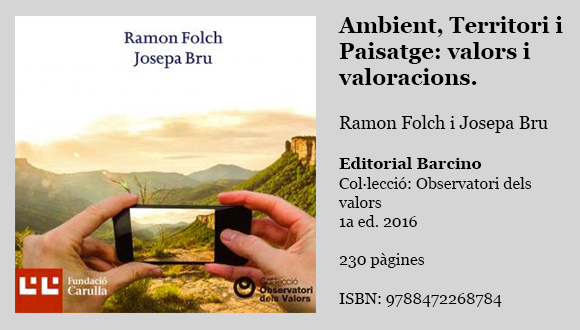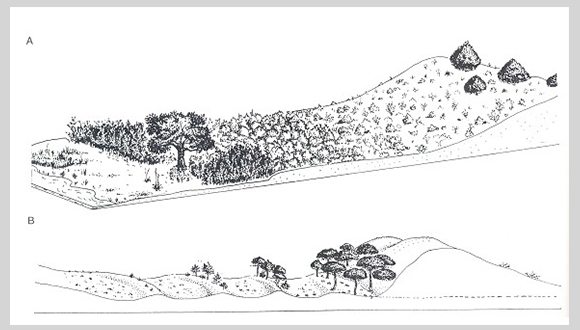Sustainability thinking
In this entry, Jaume Terradas reflects and recommends the book Ambient, Territori i Paisatge: Valors i Valoracions, by Ramon Folch and Josepa Bru.

Ambient, territori i paisatge: valors i valoracions is the title of the book recently published by socio-ecologist Ramon Folch and geographer Josepa Bru. This is a brave attempt to confront the embroiled amount of concepts in which are more or less lost those who deal, from different points of view, with the ‘environmental question’. The objective, already stated in the title, is to speak of values and valuations. The authors put the finger on the sore. In my last article on The Roots of Heaven, I said that there are two predominant visions: those who defend a reformist ecology that insists on valuing natural resources and services in a quantified way, trying that they can be included in the accounts of each project and, on the other hand, those who start from a radical ethical approach (to simplify, I talked about deep ecology, although this philosophical current seems to have gone out of fashion: I meant in any case to put values ahead, as do most environmental movements). With this rude binary classification (in fact, there is a great mix of points of view and ways of acting), I tried to separate those who believe that our economic model must be corrected with technological and methodological contributions from those who believe that it is necessary to change it entirely (in what direction, it is already a different question, and there are more proclamations than programs). Well, the authors try to show that thinking about values or valuations does not necessarily imply incompatible views. To do this, they start from a genealogy of the basic concepts from the Renaissance to the present. Since today everyone understands different things for words like environment, territory or landscape, then this task is certainly necessary.

- Landscapes have often been depicted with catena schemes. A) Vegetation of a stabilized dune in Doñana: changes in communities related to topograpgy are seen. B) Schematic cut of a typical corral of Doñana and dunes limiting it and advancing as they bury the pine community. Source: Ecología de la Vegetación (Jaume Terradas, Editorial Omega, 2001)
With this rude binary classification (...), I tried to separate those who believe that our economic model must be corrected with technological and methodological contributions from those who believe that it is necessary to change it entirely (in what direction, it is already a different question, and there are more proclamations than programs).
In science it is frequent the use of common words as ‘force’ or ‘energy’, and in their scientific sense these concepts are well defined and we know how to measure them. But much pseudo-medicine and some beliefs use the term ‘energy’ in a rather mystical way that has nothing to do with the accuracy of physics. This is the great difficulty the book faces with. It tells us the difference between environment, territory and landscape, between preservationism, conservationism and environmentalism, etc., in an intelligible way that could serve as a basis for an interdisciplinary development, able to really understand how to preserve values and also how to make valuations. Of course, the road remain still full of obstacles. Physicists know how and in which units to measure energy, but the words environment, territory and landscape designate extraordinary complexities...
The territory is, according to the authors, a "fragment of planetary surface structured in a certain way and administered by a concrete human collectivity".
The biophysical matrix has been modified by humans to do, Folch and Bru say, an ‘environmental matrix’ in an opportunistic way, without a preconceived plan or an appropriate knowledge. The anthropic appropriation of the environment conforms the territory, which is, according to the authors, a "fragment of planetary surface structured in a certain way and administered by a concrete human collectivity". This definition, although increasingly more true, raises a question: there are territories such as Antarctica where the role of humans is still limited but we call them territories. And the others, if they were not territories before human appropriation, then what were they? To talk about biophysical matrices may be better but I doubt that this expression will become of ordinary use.

Similar problems appear when talking about landscape. The authors consider that "the territory is a system and the landscape an algorithm, the aspect of the territory, the facade of reality". Sometimes it seems that they hold this idea, much in the tradition of social sciences: "the landscape does not exist if no one perceives it". It is like to say that stars do not exist if nobody looks at them. For us, humans, everything obviously is understood through culture, but is there not here a risk of falling into a species solipsism? It is obvious that things have the names that we have given them from a certain historical moment, before they were there but nobody named them. I find natural to speak about Carboniferous territories and landscapes, when there were still no humans and then no appropriation. This is just a sample of the topic’s difficulty. The relative inability of ecology (think, however, about agroecology, urban ecology, the H.T. Odum school…) to include social aspects explains the eagerness to recognize the active human presence (the authors admit that, in the same way, social scientists should not forget the biophysical matrix). In any case, they rightly say that the reconstruction of the environmental matrix "is a sustainability objective." It is a question of inserting societies in the Biosphere for a sustainable construction of environment and territories. In ecology this means that we should build our species niche sustainable.
It is a question of inserting societies in the Biosphere for a sustainable construction of environment and territories. In ecology this means that we should build our species niche sustainable.
The book's treatment of the idea of nature and the thoughts of Buffon, Goethe, Humboldt and Darwin is very good. The absence of the landscape in ecology, that the authors criticize, came mainly from the 1980s when a critique of the holism in the ecological ideas of Hutchinson, Odum, Margalef, etc. was made and reductionist approaches became dominant. It is true that the mathematical models used since the twenties (Volterra and Lotka, etc.) had no spatial dimension (Margalef was referring to this by saying that models make the ecosystems dance at a needle’s tip). And it is also true that landscape was not often mentioned nor was an objective of direct study in the period between the geo-botany of the first half of the 20th century to the late appearance of Richard Forman's landscape ecology. But the ecosystem watershed concept was developed, transects following catenas were used in many diversity studies, and the distribution of the biological life-forms or comparative ecophysiology were subjects based on landscape: one thing are mathematical models and another the field studies that have always considered space but perhaps not so explicitly landscape.

The authors address the same accusation of ignoring landscape to environmental education, and I do not know if it is fair. Environmental education is a phenomenon so unstructured that a statistical study would be necessary to see if they are right. When I dedicated myself to this topic in the 1970s and 1980s, landscape was very present (the subject interested F.G. Bernáldez, to whom the authors dedicate the book, as well as me and other colleagues). A different question is that the environmental education, in general, has not reached its aims (Terradas 2017).
The book is an important contribution that will help to illuminate the polysemic labyrinth that makes difficult to progress towards sustainability today: although there is much work to do and much to discuss, the book opens a way. This is a work that I undoubtedly recommend.
The vocation of interacting with other disciplines to move from a simple diagnosis to a sustainability project is an essential aspect of the book proposal that is firmly expressed in the last chapter: we must learn to defend values and to evaluate processes and functions. The proposal is intellectually potent, as it could not be less coming from those who come, and therefore it is also risky in a mediocre cultural environment in which philosophical and scientific controversies that have echoed in the United States and part of Europe often have passed unnoticed. In short, the book is an important contribution that will help to illuminate the polysemic labyrinth that makes difficult to progress towards sustainability today: although there is much work to do and much to discuss, the book opens a way. This is a work that I undoubtedly recommend.
Folch, R., J. Bru. (2017). Ambient, territori, paisatge: Valors i valoracions. Col·lecció Observacio dels Valors, Fundació Carulla. Ed. Barcino, Barcelona, 226 pp.
Terradas, J. (2017). Educació ambiental: D’on venim, cap on anem? Una visió personal. A Educació ambiental: d’on venim, cap on anem? Col·lecció Estudis, sèrie Medi Ambient, pp. 15-52, Diputació de Barcelona, amb traduccions al castellà i l’anglès. Barcelona, 559 pp.







